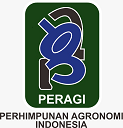Karakterisasi Jamur Penyebab Penyakit Busuk Pangkal Batang (Basal Rot) pada Bawang Wakegi (Allium x wakegi Araki)
Abstract
Bawang wakegi merupakan hasil persilangan alami antara bawang merah (Allium cepa L. aggregatum group) dan bawang daun (Allium fistulosum L.). Salah satu faktor yang mengganggu pertumbuhan dan mempengaruhi hasil produksi bawang wakegi di lapang adalah keberadaan penyakit busuk pangkal batang (basal rot) atau layu Fusarium. Penyakit ini disebabkan oleh banyak spesies dari jamur patogen Fusarium spp yang berbeda. Penelitian ini bertujuan untuk menentukan karakteristik jamur patogen busuk pangkal batang yang menyerang bawang wakegi sehingga dapat dipastikan patogen penyebabnya. Tahapan penelitian meliputi pengambilan sampel, isolasi jamur, uji patogenisitas, dan karakterisasi secara makroskopis dan mikroskopis. Hasil karakterisasi jamur patogen yang menginfeksi bawang wakegi mengarah pada karakteristik jamur F. oxysporum f.sp. cepae.
Keywords
Full Text:
PDFReferences
Alemu, A. C. (2015). Diversity of Onion Basal Rot (Fusarium Isolates) and Their Management Isolates Under Laboratory and Glasshouse Conditions. [Addis Ababa University, Ethiopia.]. http://213.55.95.56/bitstream/handle/123456789/987/Abreham Chebte.pdf? sequence=2&isAllowed=y
Aprilia, I., Maharijaya, A., & Wiyono, S. (2020). Keragaman Genetik dan Ketahanan terhadap Penyakit Layu Fusarium (Fusarium oxysporum f.sp cepae) Bawang Merah (Allium cepa L. var. aggregatum) Indonesia. Jurnal Hortikultura Indonesia, 11(1), 32–40. https://doi.org/10.29244/jhi.11.1.32-40
Arie, T. (2019). Fusarium diseases of cultivated plants, control, diagnosis, and molecular and genetic studies. Journal of Pesticide Science, 44(4), 275–281. https://doi.org/10.1584/jpestics.J19-03
Behrani, G. Q., Syed, R. N., Abro, M. A., Jiskani, M. M., & Khanzada, M. A. (2015). Pathogenicity and chemical control of basal rot of onion caused by Fusarium oxysporum f. sp. cepae. Pakistan. J Agric Agric Eng Vet Sci., 31, 60–70. https://sau.edu.pk/pjaaevs/index.php/ojs/article/view/134
Bektas, I., & Kusek, M. (2019). Phylogenetic and morphological characterization of Fusarium oxysporum f. sp. cepae the causal agent of basal rot on onion isolated from Turkey. Fresenius Environmental Bulletin, 28(3), 1733–1742.
Black, L., Conn, K., Gabor, B., Kao, J., & Lutton, J. S. (2012). Onion Disease Guide: a Practical Guide for Seedmen Growers and Agricultural Advisors. Seminis Vegetable Seeds, Inc., USA. https://www.yumpu.com/en/document/read/10936143/onion-disease-guide-seminis
Cramer, C. S., Ubhankar Mandal, U., Sharma, S., Nourbakhsh, S. S., Goldman, I., & Ivette Guzman, I. (2021). Review : Recent Advances in Onion Genetic Improvement. Agronomy, 11, 482. https://doi.org/https://doi.org/10.3390/agronomy11030482
Ezepchuk, Y. V. (2013). Biology of pathogenicity (Theoretical Review). Annual Review and Research in Biology, 3(4), 805–813. https://www.journalarrb.com/index.php/ARRB/ article/view/24899/46564
Fadhilah, S., Wiyono, & Surahman, M. (2014). Pengembangan teknik deteksi Fusarium patogen pada umbi benih bawang merah (Allium ascalonicum) di Laboratorium [Development of detection technique for Fusarium pathogen on seedling shallot (Allium ascalonicum) Bulb at Laboratorium]. Jurnal Hortikultura, 24(2), 171–178. https://doi.org/http://dx.doi.org/10.21082/jhort.v24n2.2014.p171-178
Fitriani, M. L., Wiyono, S., & Sinaga, M. S. (2019). Potensi kolonisasi Mikoriza Arbuskular dan Cendawan Endofit untuk Pengendalian Layu Fusarium pada Bawang Merah. Jurnal Fitopatologi Indonesia, 15(6), 228 – 238. https://doi.org/https://doi.org/10.14692/jfi.15.6.228-238
Haapalainen, M., Latvala, S., Kuivainen, E., Qiu, Y., Segerstedt, M., & Hannukkala, A. O. (2016). Fusarium oxysporum , F. proliferatum and F. redolens associated with basal rot of onion in Finland. Plant Pathology, 65(8), 1310–1320. https://doi.org/10.1111/ppa.12521
Hartati, S., Rustiani, U. S., Puspasari, L. T., & Kurniawan, W. (2016). Vegetatif compatibility of Fusarium oxysporum on various hosts. Jurnal Agrikultura, 27(3), 132–139. https://doi.org/https://doi.org/10.24198/agrikultura.v27i3.10875
Herlina, L., Istiaji, B., & Wiyono, S. (2021). The Causal Agent of Fusarium Disease Infested Shallots in Java Islands of Indonesia. E3S Web of Conferences, 232, 03003. https://doi.org/10.1051/e3sconf/202123203003
Hikmahwati, H., Auliah, M. R., Ramlah, R., & Fitrianti, F. (2020). Identifikasi Cendawan Penyebab Penyakit Moler Pada Tanaman Bawang Merah (Allium Ascolonicum L.) Di Kabupaten Enrekang. AGROVITAL : Jurnal Ilmu Pertanian, 5(2), 83. https://doi.org/10.35329/agrovital.v5i2.1745
Kalman, B., Abraham, D., Graph, S., Perl-Treves, R., Meller Harel, Y., & Degani, O. (2020). Isolation and Identification of Fusarium spp., the Causal Agents of Onion (Allium cepa) Basal Rot in Northeastern Israel. Biology, 9(4), 69. https://doi.org/10.3390/biology9040069
Le, D., Audenaert, K., & Haesaert, G. (2021). Fusarium basal rot: profile of an increasingly important disease in Allium spp. Tropical Plant Pathology, 46(3), 241–253. https://doi.org/10.1007/s40858-021-00421-9
Leoni, C., de Vries, M., ter Braak, C. J. F., van Bruggen, A. H. C., & Rossing, W. A. H. (2013). Fusarium oxysporum f.sp. cepae dynamics: in-plant multiplication and crop sequence simulations. European Journal of Plant Pathology, 137(3), 545–561. https://doi.org/10.1007/s10658-013-0268-6
Miishra, R. K., Jaiswal, R. K., Kumar, D., Saabale, P. R., & Singh, A. (2014). Management of major diseases and insect pests of onion and garlic: A comprehensive review. Journal of Plant Breeding and Crop Science, 6(11), 160–170. https://doi.org/10.5897/JPBCS2014.0467
Nishioka, T., Marian, M., Kobayashi, I., Kobayashi, Y., Yamamoto, K., Tamaki, H., Suga, H., & Shimizu, M. (2019). Microbial basis of Fusarium wilt suppression by Allium cultivation. Scientific Reports, 9(1), 1715. https://doi.org/10.1038/s41598-018-37559-7
Rampersad, S. (2020). Pathogenomics and Management of Fusarium Diseases in Plants. Pathogens, 9(5), 340. https://doi.org/10.3390/pathogens9050340
Rana, A., Sahgal, M., & Johri, B. N. (2017). Fusarium oxysporum: Genomics, Diversity and Plant–Host Interaction. In Developments in Fungal Biology and Applied Mycology (pp. 159–199). Springer Singapore. https://doi.org/10.1007/978-981-10-4768-8_10
Shamyuktha, J., Sheela, J., Rajinimala, N., Jeberlinprabina, B. M., & Ravindran, C. (2020). Survey on Onion Basal Rot Disease Incidence and Evaluation of Aggregatum Onion (Allium cepa L. Var. Aggregatum Don.) Genotypes Against Fusarium oxysporum f. sp. Cepae. International Journal of Current Microbiology and Applied Sciences, 9(7), 529–536. https://doi.org/10.20546/ijcmas.2020.907.058
Southwood, M. J., Viljoen, A., & McLeod, A. (2015). Inoculum sources of Fusarium oxysporum f.sp. cepae on onion in the Western Cape Province of South Africa. Crop Protection, 75, 88–95. https://doi.org/10.1016/j.cropro.2015.05.014
Vagany, V. (2012). Characterisation of Fusarium Pathogens in the UK [University of Warwick. British English]. http://wrap.warwick.ac.uk/56393/1/ WRAP_ THESIS_ Vagany_2012.pdf
Refbacks
- There are currently no refbacks.



























